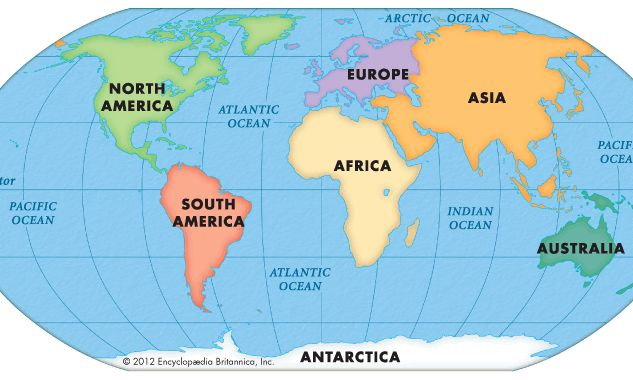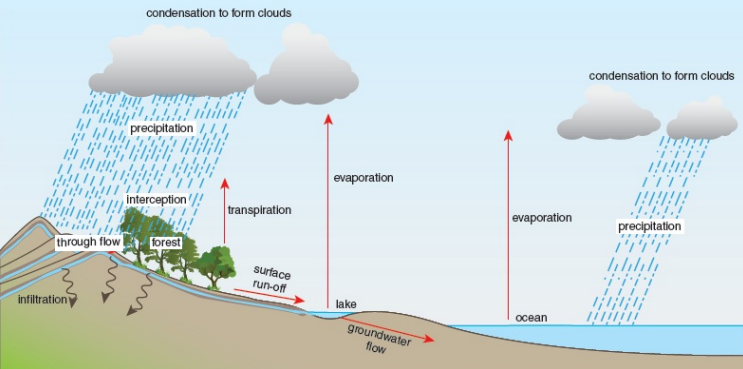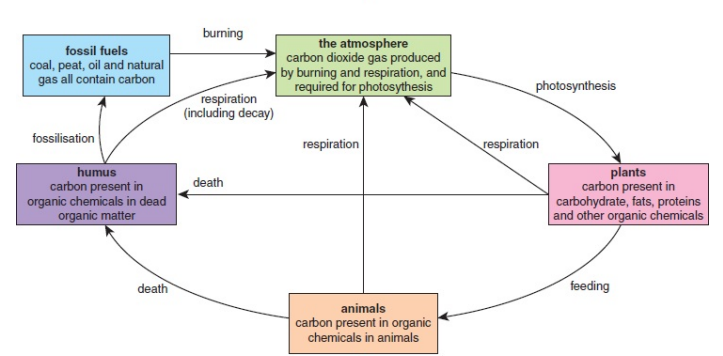Unit 1 - Introduction to Environmental Management
1.1 Continents and oceans

7 continents & 5 oceans
1.2 Country Classification by income level
LICs: low-income economies (Gross Nat’l Income per capita < $1086)
e.g) Uganda, Chad, and Ethiopia; Africa has the most LICs
MICs: middle-income economies
HICs: high-income economies (GNI per capita > $13,205)
e.g) Canada, U.S.A., Sweden
Biggest impact on global climate
1.3 Sustainability
Sustainability: the ability to meet the needs of the present without compromising the ability of future generations to meet their own needs
Must take into account environmental, social, and economic factors
We are living unsustainably, due to factors like population growth and a finite # of resources
1.4 The water cycle
Evaporation: liquid turns into vapor; enters the atmosphere
Condensation: vapor turns into liquid
Precipitation: liquid water or ice particles fall to the Earth
Interception: precipitation is stopped from reaching the ground by the presence of trees and other plants
Infiltration: water seeps into the ground
Surface run-off: precipitation that runs over the ground into streams/rivers
Through-flow: infiltrated water flows through the soil
Groundwater flow: infiltrated water flows through rocks
Transpiration: movement of water up plants & into vapor; it enters the atmosphere

1.5 The structure and composition of the atmosphere
The Earth’s atmosphere is composed of: nitrogen, oxygen, carbon dioxide, argon, and water vapor
Try Some Milk Then Eggs
Atmospheric pressure decreases with height
Troposphere (0-15km): where we live
Temp. decreases w/height; wind speeds increase w/height
Where global warming occurs
Tropopause = top layer
Stratosphere (~15-50km): contains the ozone layer
Temp. increases w/height
Stratopause = top layer
Ozone: absorbs UV radiation
10-50km above the surface
Protects from skin cancer, a weakened immune system, & damage to vision/cataracts
Mesosphere (~50-80km): no dust, ozone, or water vapor
Temp. declines dramatically the higher up this layer extends
Mesopause = top layer
Thermosphere (80-1000km):
Temp. rises rapidly with height → absorbs UV rays
Thermopause = top layer
Greenhouse effect:
UV radiation passes through the Earth’s atmosphere and is absorbed the Earth’s surface
Some energy is re-emitted back into the atmosphere as infrared radiation
GHGs absorb some of this infrared radiation, preventing it from leaving the atmosphere
1.6 Ecosystems
Biome: a form of ecosystems that are smaller than the biosphere; a geographical region w/specific climate, vegetation, and animal life
Ecosystem: all living things (biotic) together with all non-living things (abiotic) in an area
Biotic factors: producers, consumers, and decomposers
Abiotic factors: temperature, humidity, water, oxygen, light, pH
Population: all the organisms of one species living in a defined area
Community: a group of populations of different species that live together in an area and interact with each other
Habitat: the place within an ecosystem where an organism lives
Niche: the role of a species within the ecosystem
Biotic interactions
Competition: both organisms require the same resource
Intraspecific: 2 members of the same species
Interspecific: 2 different species
Grazing: when species move from one victim to another w/o fully killing its victim
Predation: one organism consumes another in a dominant relationship
Photosynthesis: the process by which plants synthesise glucose using carbon dioxide, water and energy from sunlight
carbon dioxide + water → glucose + oxygen (COWS → GO)
6CO2 + 6H2O → C6H12O6 + 6O2
Chlorophyll captures light energy for photosynthesis
Limiting factors: availability of water, concentration of carbon dioxide & the availability of light
Photosynthesis by marine autotrophs (e.g. phytoplankton) turn carbon into organic matter
Carbon reservoir in the atmosphere → fixation by photosynthesis → in living things
Carbon found in living things as carbohydrates, proteins, fats, etc.
Food chains
Producers: organisms within an ecosystem that can carry out photosynthesis
Primary consumer: organisms within an ecosystem that derive their food from producers
Secondary consumer: organisms within an ecosystem that derive their food from primary consumers
Tertiary consumer: organisms within an ecosystem that derive their food from secondary consumers
Decomposer: organisms within an ecosystem that derive their food from the bodies of dead organisms
Trophic levels = feeding levels within food chains
Energy is transferred between organisms in a food chain; starts with a producer
Energy is lost as respiration and waste products
Aerobic respiration: the chemical reactions in cells that break down glucose molecules and release energy, carbon dioxide and water
glucose + oxygen → carbon dioxide + water
C6H12O6 + 6O2 → 6CO2 + 6H2O
Carbon cycle

The ocean, atmosphere, and land are the biggest carbon reservoirs